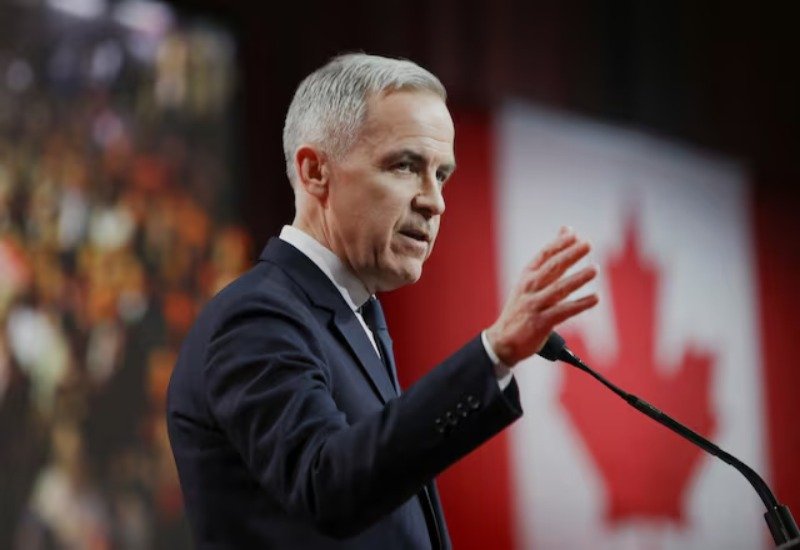- Mark Carney will be sworn in as Canada’s 24th prime minister on Friday.
- Carney aims to address US trade tensions and counter President Trump’s threats.
- Canada plans retaliatory tariffs on US goods worth over CA$29 billion.
- Carney advocates for renewed economic cooperation with the US, emphasizing Canadian sovereignty.
- Canada’s Foreign Minister criticizes Trump’s shifting justifications for tariffs.
Mark Carney will take the oath of office as Canada’s 24th prime minister on Friday morning. This ceremony will mark the end of Justin Trudeau’s nine-year leadership. Governor General Mary Simon will preside over the event at 11 a.m. local time, officially ushering in a new era.
Carney, a former central banker, has led both the Bank of Canada and the Bank of England. Earlier this week, he was elected leader of the Liberal Party. His leadership comes at a crucial time, with tensions growing between Canada and the United States, particularly over trade.
As Carney steps into office, he faces several challenges. The ongoing trade dispute with the US is the most pressing. President Trump’s tariffs on Canadian steel and aluminum have escalated tensions, sparking backlash in Canada. However, Carney has expressed his readiness to engage in talks, provided Canada’s sovereignty is respected.
In addition, Carney’s cabinet will be smaller than Trudeau’s. It is expected to include between 15 and 20 ministers, a significant reduction from Trudeau’s 37 ministers. This change highlights Carney’s intent to shift the political landscape and streamline Canada’s government.
Trade War with the US
The trade conflict between Canada and the US began when President Trump imposed a 25% tariff on steel and aluminum imports from Canada. Since Canada is the US’s largest foreign supplier of these materials, the country felt the impact immediately. This move sparked tensions between the two nations.
In response, Carney showed his willingness to meet with Trump. However, he made it clear that any discussions should respect Canadian independence. “I am ready to sit down with President Trump at the appropriate time under a position where there is respect for Canadian sovereignty,” Carney said.
Soon after, the US imposed another 25% tariff on Canadian steel and aluminum. Many experts now believe this decision could harm industries on both sides of the border. To retaliate, Canada announced plans to impose tariffs worth CA$29.8 billion on US goods, including steel, aluminum, and various consumer products.
Canada’s Retaliation
The Canadian government acted quickly and firmly against Trump’s tariffs. Foreign Minister Mélanie Joly immediately called the US actions “unjustified.” She accused Trump of using changing excuses for his tough trade policies. Furthermore, Joly pointed out that Canada had already addressed US concerns in the past.
In response, Carney, Canada’s spokesperson, shared their position: “We don’t want to do this because we believe in open borders and free and fair trade.” However, he emphasized that Canada had to take these retaliatory measures because of the unjustified tariffs placed on Canadian industries.
This move is not Canada’s first response. Earlier in March, Canada targeted US imports worth CA$30 billion. The 25% tariffs primarily focused on steel, aluminum, and consumer goods. This came after Trump’s delayed tariff announcement, which still posed significant challenges to Canada’s economy.
Trump’s Remarks and Canada’s Trade Tensions
President Trump’s frequent comments about Canada’s sovereignty have only complicated trade tensions. He has repeatedly suggested that Canada should become the 51st state, which has angered many in Canada. In response, Foreign Minister Joly voiced her frustration, calling Trump’s remarks disrespectful and damaging to bilateral relations.
Joly made it clear, saying, “The only constant in this unjustifiable trade war seems to be President Trump’s talk of annexing our country.” Furthermore, she criticized the ever-changing justifications for the tariffs. She pointed out that the national security argument didn’t hold, especially given Canada’s significant contribution to US security.
Meanwhile, Carney has emphasized the importance of rebuilding a strong trade partnership with the US. Despite the ongoing trade war, Carney remains hopeful, stating, “The greatest economic and security partnership in the world is renewed, relaunched. That is possible.” This reflects his broader goal of restoring economic ties.
Carney’s approach to the conflict shows his commitment to addressing both economic and political challenges. While some view his willingness to engage with Trump as practical, others worry about potential concessions. These concessions could weaken Canada’s position in the long run, especially if they compromise national interests.
As Carney prepares to take office, the future of Canada’s relationship with the US is uncertain. The trade war still rages, and tensions between the two countries could intensify. However, Carney’s leadership will play a vital role in shaping Canada’s trade policies and overall standing in the international arena.
In the coming weeks, Carney will face a delicate balancing act. He must maintain Canada’s sovereignty while working to resolve the trade dispute with the US. Whether he can mend ties with Trump while protecting Canada’s economic interests remains to be seen.


